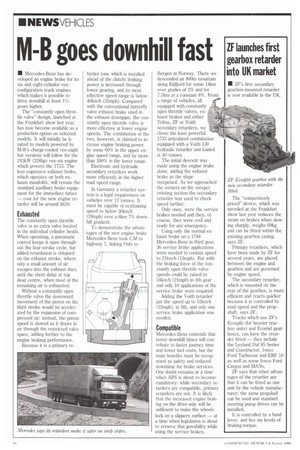IN - 13 goes downhill fast
Page 12

If you've noticed an error in this article please click here to report it so we can fix it.
• Mercedes-Benz has developed an engine brake for its six and eight-cylinder veeconfiguration truck engines which makes it possible to drive downhill at least 11/2 gears higher.
The "constantly open throttle valve" design, launched at the Frankfurt show last year, has now become available as a production option on selected models. It will initially be limited to models powered by M-B's charge-cooled vee-eight but versions will follow for the 243kW (326hp) vee-six engine which powers the 1733. The less expensive exhaust brake, which operates on both exhaust manifolds, will remain the standard auxilliary brake equipment for the immediate future — cost for the new engine retarder will he around 2620.
Exhausted
The constantly open throttle valve is an extra valve located in the individual cylinder heads. When operating, a pneumatic control keeps it open throughout the four-stroke cycle, but added retardation is obtained on the exhaust stroke, where only a small amount of air escapes into the exhaust duct, until the short delay at top dead centre, when most of the remaining air is exhausted.
Without a constantly open throttle valve the downward movement of the piston on the third stroke would be accelerated by the expansion of compressed air; instead, the piston speed is slowed as it draws in air through the restricted valve space, adding further to the engine braking performance.
Because it is a primary re tarder (one which is installed ahead of the clutch) braking power is increased through lower gearing, and its most effective speed range is below 40km/h (25mph). Compared with the conventional butterfly valve exhaust brake sited in the exhaust downpipe, the constantly open throttle valve is more effective at lower engine speeds. The combination of the two, however, is claimed to increase engine braking power by some 60% in the upper engine speed range, and by more than 100% in the lower range.
Electronic and hydraulic secondary retarders work more efficiently in the higher road speed range.
In Germany a retarder system is a legal requirement on vehicles over 12 tonnes. It must be capable of restraining speed to below 30km/h (19mph) over a 6km 7% downhill gradient.
To demonstrate the advantages of the new engine brake Mercedes-Benz took CM to highway 7, linking Oslo to
Bergen in Norway. There we descended an 800m mountain along Eiclfiord for some 14km over grades of 2% and for 7.5km at a constant 8%. From a range of vehicles, all equipped with constantly op'en throttle valves, exhaust brakes and either Telma, ZF or Voith secondary retarders, we chose the least powerful 1733 articulated combination equipped with a Voith 130 hydraulic retarder and loaded at 40 tonnes.
The initial descent was made using the engine brake alone, adding the exhaust brake as the slope steepened. As we approached the corners on the steeper twisting section the secondary retarder was used to check speed further.
Only once, were the service brakes needed and then, of course, they were cool and ready for any emergency.
Using only the normal exhaust brake on a 1748 Mercedes-Benz in third gear, 36 service brake applications were needed to contain speed to 21km/h (13mph). But with the braking force of the constantly open throttle valve speeds could be raised to 34km/h (21mph) in 4th gear and only 10 applications of the service brake were required.
Adding the Voith retarder put the speed up to 52krn/h (32mph), in 5th, and only one service brake application was needed.
Compatible
Mercedes-Benz contends that faster downhill times will contribute to faster journey time and lower fuel costs, but the main benefits must be recognised as safety and reduced downtime for brake services. One doubt remains at a time when ABS is about to become mandatory: while secondary retarders are compatible, primary retarders are not. It is likely that the increased engine braking on the drive-axle will be sufficient to make the wheels lock on a slippery surface — at a time when legislation is about to remove that possibility while using the service brakes.












































































































